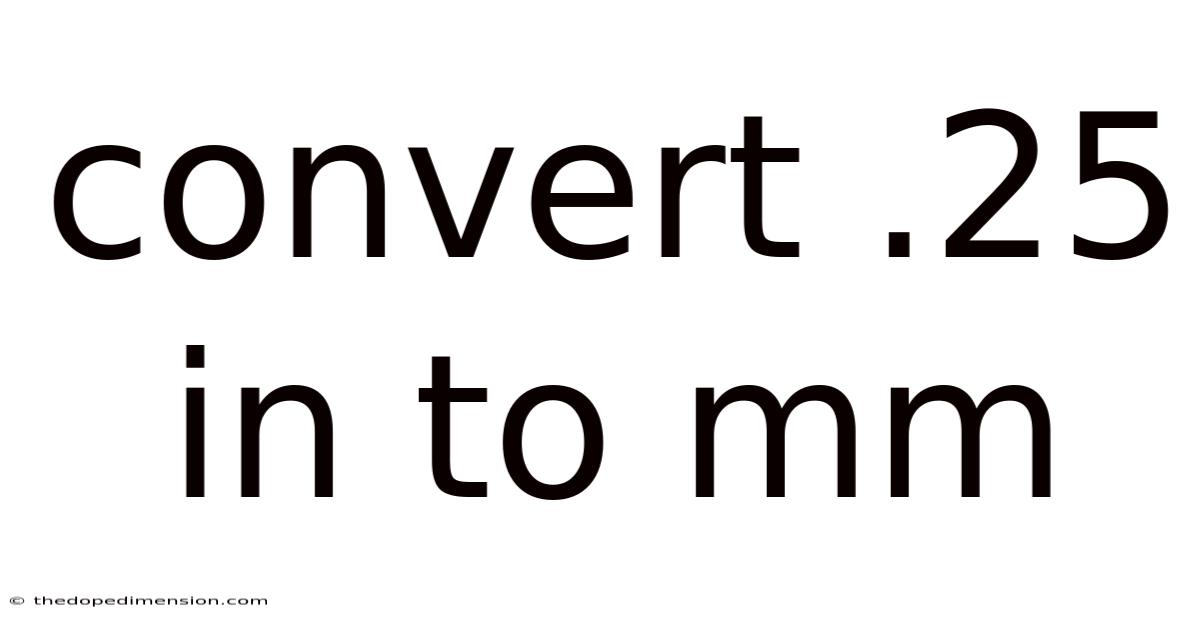Convert .25 In To Mm
thedopedimension
Sep 11, 2025 · 4 min read

Table of Contents
Converting 0.25 Inches to Millimeters: A Comprehensive Guide
Converting units of measurement is a fundamental skill in many fields, from engineering and manufacturing to everyday tasks like cooking and crafting. This comprehensive guide will walk you through the process of converting 0.25 inches (in) to millimeters (mm), explaining the underlying principles and offering practical applications. Understanding this conversion is crucial for anyone working with measurements across different systems. We'll cover the conversion itself, explore the history of these units, delve into the scientific basis for the conversion factor, and address frequently asked questions.
Understanding Inches and Millimeters
Before we begin the conversion, let's clarify the units involved. Inches (in) are a unit of length in the imperial system of measurement, historically based on the length of the human thumb. Millimeters (mm) are a unit of length in the metric system, a decimal system based on powers of ten. The metric system's consistency makes conversions within the system straightforward.
The difference between these systems lies in their foundation and scale. The imperial system is less organized, with various arbitrary relationships between units. The metric system, on the other hand, is based on a coherent set of units, with prefixes denoting multiples of ten (e.g., kilo, milli, centi). This makes calculations much simpler.
The Conversion Process: 0.25 Inches to Millimeters
The key to converting 0.25 inches to millimeters lies in the conversion factor. One inch is exactly equal to 25.4 millimeters. This is a fixed and internationally agreed-upon value. Therefore, to convert 0.25 inches to millimeters, we simply multiply 0.25 by 25.4:
0.25 in * 25.4 mm/in = 6.35 mm
Therefore, 0.25 inches is equal to 6.35 millimeters.
A Deeper Dive: The Scientific Basis of the Conversion Factor
The exact relationship between the inch and the millimeter wasn't always precisely defined. Early definitions of the inch varied across different regions and time periods. The modern definition of the inch stems from its relationship to the meter, the fundamental unit of length in the metric system.
The meter was initially defined in 1793 as one ten-millionth of the distance from the North Pole to the Equator along a meridian passing through Paris. While this definition has been refined over time (currently based on the speed of light), it established the foundation for the metric system.
The inch's relationship to the meter was later established through careful measurement and international agreement. The value of 25.4 mm per inch is not a rounded number but a precisely defined conversion factor, ensuring accuracy in scientific and engineering applications. This precise definition facilitates seamless transitions between imperial and metric systems.
Practical Applications of the Conversion
The conversion of inches to millimeters has widespread practical applications across numerous fields. Here are a few examples:
-
Manufacturing and Engineering: Precision engineering relies heavily on accurate measurements. Converting between inches and millimeters is essential for designing, manufacturing, and assembling components with international collaborations. Errors in conversion can lead to significant problems.
-
3D Printing: Many 3D printers accept design files in both imperial and metric units. Accurate conversion ensures that the printed object matches the intended dimensions.
-
Construction: In international construction projects, converting units is crucial for consistent measurements and accurate building plans.
-
Woodworking and Carpentry: Many woodworking plans and materials are specified in inches, but tools and techniques might use metric measurements. Converting between the two is essential for accurate work.
-
Everyday Life: Even in everyday situations, understanding the conversion can be helpful. For example, knowing that a quarter-inch is about 6.35 millimeters can be useful when dealing with small objects or measurements.
Frequently Asked Questions (FAQ)
Here are some common questions regarding inch-to-millimeter conversions:
Q: Is the conversion factor 25.4 mm/in always exact?
A: Yes, the conversion factor of 25.4 mm/in is an exactly defined value, not an approximation.
Q: How can I convert other inch measurements to millimeters?
A: You can simply multiply the inch measurement by 25.4 mm/in. For example, to convert 2 inches to millimeters, you'd calculate: 2 in * 25.4 mm/in = 50.8 mm
Q: Are there online converters for inches to millimeters?
A: Yes, many websites offer online calculators for unit conversions, including inches to millimeters. However, understanding the underlying process is more beneficial in the long run.
Q: Why is it important to be accurate with unit conversions?
A: Inaccurate conversions can lead to errors in design, manufacturing, construction, and other fields, potentially resulting in safety hazards, financial losses, and project failures.
Q: Can I use a different conversion factor?
A: While approximate conversion factors exist, using the precise value of 25.4 mm/in ensures the highest level of accuracy.
Conclusion: Mastering Unit Conversions
Mastering unit conversions, particularly between the imperial and metric systems, is an invaluable skill. Converting 0.25 inches to millimeters is a simple yet fundamental example of this process. Understanding the conversion factor, its scientific basis, and its practical applications will significantly enhance your problem-solving abilities in various fields. The precision offered by using the correct conversion factor ensures accuracy and avoids potential errors that could have significant consequences. Remember that attention to detail in measurements is paramount in many professional settings. While using online tools can be helpful, understanding the mathematical principles behind unit conversions is crucial for a deeper understanding of measurement and its applications.
Latest Posts
Latest Posts
-
1 3 8 In In Mm
Sep 11, 2025
-
250 Canadian Dollars To Us
Sep 11, 2025
-
What Is 500cm In Feet
Sep 11, 2025
-
How Big Is 39 Cm
Sep 11, 2025
-
How Much Is Five Liters
Sep 11, 2025
Related Post
Thank you for visiting our website which covers about Convert .25 In To Mm . We hope the information provided has been useful to you. Feel free to contact us if you have any questions or need further assistance. See you next time and don't miss to bookmark.